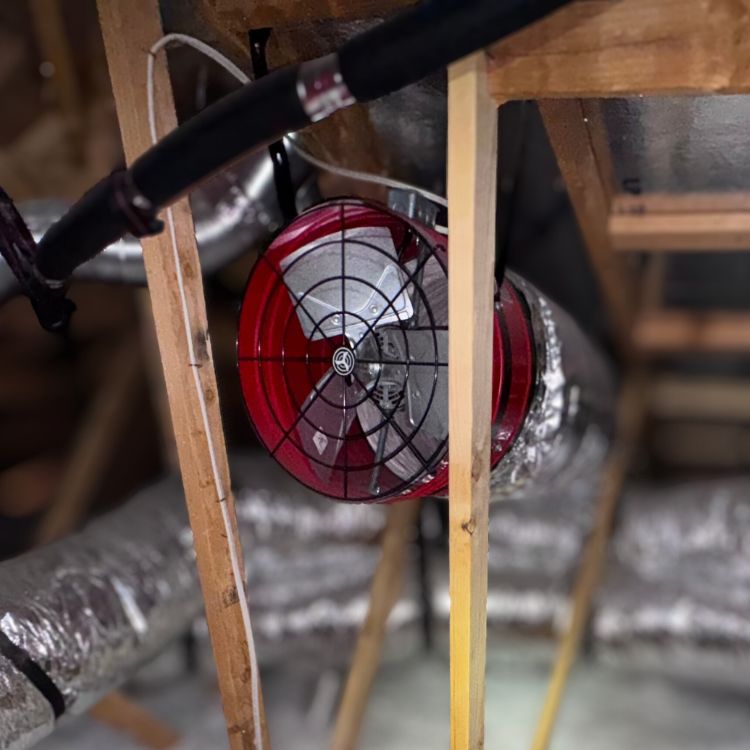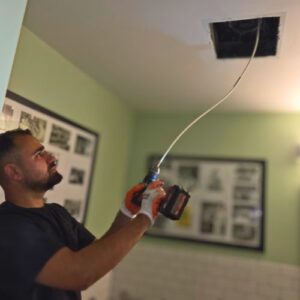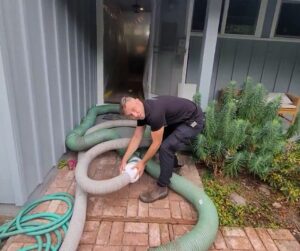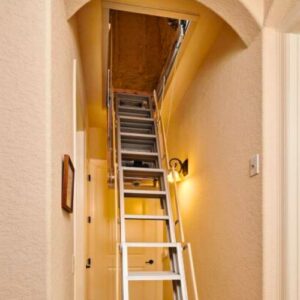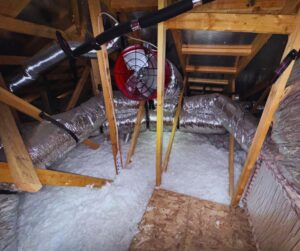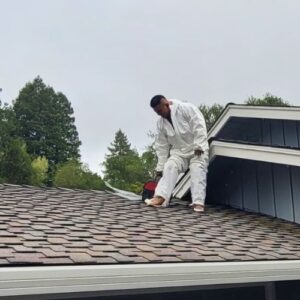At Miller Attics, we’ve worked in hundreds of homes across California, and one of the most common questions we hear is about the attic fan. Some homeowners love it, others aren’t sure if it’s helping, and many simply want to know how to take care of it, replace it, or turn it off.
In this guide, we’ll share everything you need to know, based on years of hands-on experience in attics. We’ll also address the exact questions people ask in forums online: how to remove attic fan, how to replace attic fan, how to turn off attic fan, and whether it’s worth it to simply remove attic fan entirely. By the end, you’ll have a clear understanding of what attic fans do, when they make sense, and what options you have if your fan isn’t performing.
@miller.attics.ca Adding rolled insulation to the attic #attic #dark #miller ♬ Rolling – Tsav
What Does an Attic Fan Do?
An attic fan is designed to ventilate the space directly under your roof. During the summer, attic temperatures can soar well above 120°F, especially in places like California. That heat radiates down into your living spaces, making your air conditioner work harder and your energy bills rise.
The attic fan helps by pulling in cooler air from outside vents (usually soffit vents) and exhausting hot air through the fan opening. The result is a cooler attic, less strain on your HVAC system, and a more comfortable home overall.
But here’s the truth we’ve learned: an attic fan only works well if the house is properly sealed and vented. If there are leaks in your ceiling or ductwork, the fan can accidentally pull conditioned air from inside your home, which cancels out the savings. That’s why many people eventually ask: should I keep my attic fan, or just remove attic fan and rely on passive ventilation like ridge vents and soffits?
How to Remove Attic Fan
This is one of the top questions we see in online forums: “How do I remove my attic fan safely?” Homeowners often discover that their fan is noisy, broken, or simply not helping as much as they hoped.
Here’s our professional process for how to remove attic fan:
- Shut off the power. The first step is always safety. We turn off the breaker that feeds the fan to make sure no electricity is running through the circuit.
- Disconnect the wiring. We carefully open the junction box, disconnect line, neutral, and ground wires, and cap them securely.
- Unbolt the fan. Most attic fans are secured with brackets, screws, or flashing. We remove these attachments carefully to avoid damaging roof framing.
- Remove the unit. Depending on the design, we may pull the fan out through the attic, or if it’s too large, remove it from the roof side.
- Seal the opening. After we remove attic fan, we install sheathing, underlayment, and shingles to close the roof hole properly. On the attic side, we add insulation and air sealing so the home stays efficient.
We’ve seen homeowners try DIY removal, but many run into surprises—like oversized brackets that don’t fit through the attic hatch. In those cases, we dismantle the fan in parts or remove the exterior housing from the roof. Done right, removal restores your roof’s integrity and stops drafts or leaks.
How to Replace Attic Fan
Another big question: “My attic fan died—how do I replace it?” Over time, motors burn out, bearings fail, or thermostats stop working. In fact, the average lifespan of a basic attic fan motor is only 4–8 years.
Here’s our approach for how to replace attic fan:
- Select the right fan. We match the fan’s CFM (cubic feet per minute] to the size of your attic. Too small and it won’t cool enough; too large and it wastes energy. We also help clients decide between electric and solar-powered fans.
- Prepare the opening. We inspect the old fan site, fix any water damage, and ensure the opening is square and sealed.
- Install new flashing. A proper flashing job keeps water out for decades. We install it under shingles and seal it tight.
- Mount the new fan. The new attic fan is secured with brackets and hardware to keep it stable.
- Wire it correctly. We reconnect to the home’s power or solar panel, install the thermostat or humidistat, and test the system.
- Finish with insulation and sealing. From inside, we ensure there are no gaps that could leak air.
We’ve replaced attic fans for many customers who initially thought the job was simple but found out the hard way that poor flashing leads to leaks. A professionally replaced fan will work quietly and efficiently for years.
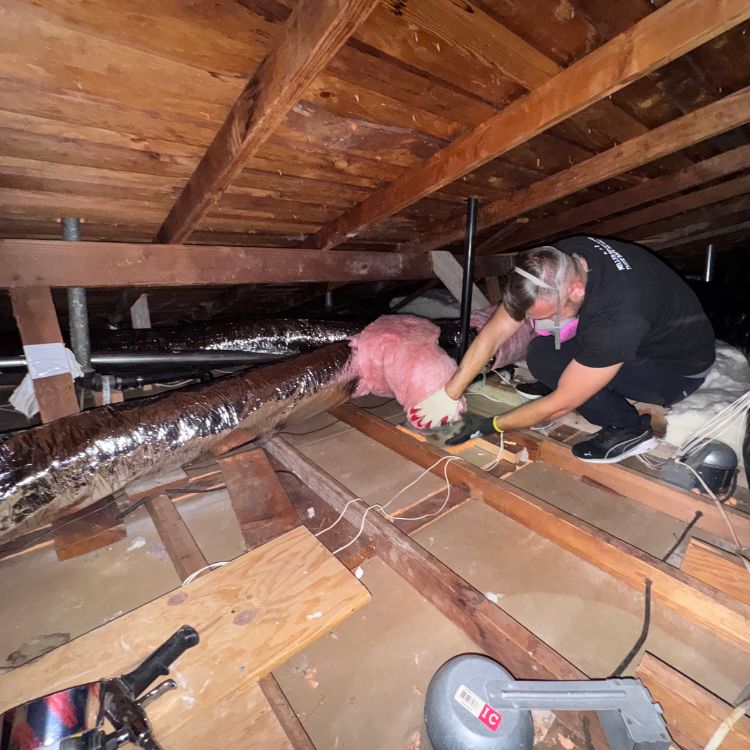
How to Turn Off Attic Fan
Not every homeowner wants their fan running all the time. In fact, a common forum question is: “How do I turn off attic fan without shutting down my whole breaker panel?”
Here’s what we recommend for how to turn off attic fan:
- Look for a switch. Many attic fans are wired to a standard wall switch near the attic hatch or in a nearby closet. It often looks like a light switch.
- Check the thermostat or humidistat. Some fans are set to turn on automatically when the attic reaches a certain temperature or humidity. Adjusting these settings can keep the fan off.
- Turn off the breaker. If you can’t find a switch, shutting off the dedicated breaker is the safest way to cut power.
- Disconnect for long-term shutdown. If you no longer want the fan, you can disconnect the wiring in the junction box and cap the wires. Then you can decide whether to leave the fan in place or fully remove attic fan.
We’ve had homeowners call us after pulling their hair out trying to find the hidden switch. The truth is, many older homes have the fan wired in unusual spots. If in doubt, a professional can trace the circuit quickly.
Remove Attic Fan: When Does It Make Sense?
Sometimes the best solution is to simply remove attic fan. We often recommend this in homes that already have excellent passive ventilation (ridge and soffit vents). Why? Because attic fans can sometimes do more harm than good if not installed correctly.
Here are situations where removal makes sense:
- The fan is pulling conditioned air from the living space du to ceiling leaks.
- The motor has failed multiple times, and replacement costs outweigh the benefit.
- The home already has ridge and soffit vents that provide adequate airflow.
- Noise or vibration is bothering the household.
In these cases, removing the fan, sealing the roof properly, and relying on passive airflow can actually improve efficiency and comfort.
Attic Fan Myths We Hear All the Time
Over the years, we’ve noticed that many homeowners misunderstand what an attic fan can do. Let’s clear up a few myths:
- Myth: An attic fan will cool my entire house.
Reality: It only cools the attic. It can reduce the load on your A/C, but it won’t replace it. - Myth: Bigger fans are always better.
Reality: Oversized fans can depressurize the attic and suck air from the living space if not balanced with intake vents. - Myth: Solar attic fans always save money.
Reality: Some do, but only if installed correctly and matched to the attic size. Otherwise, the cost may not justify the savings.
Real Examples from Our Work
One customer in Sonoma had an old attic fan that quit in the middle of a heatwave. He tried to replace it himself but discovered the unit was too large to fit through the attic opening. He called us, and we removed the exterior housing from the roof, replaced it with a new fan, and sealed everything properly. His attic temperature dropped by nearly 20°F within hours.
Another homeowner in Marin complained about high energy bills. We found that her attic fan was actually pulling cool air from her house because of leaky recessed lights. In this case, the best solution was to remove attic fan and upgrade attic insulation and air sealing. Her comfort improved, and her bills went down.
FAQs About Attic Fans
Q: Do attic fans really make a difference?
A: Yes, but only if installed in the right home. Without proper intake vents, they won’t perform as promised.
Q: How do I know if I should remove attic fan?
A: If your fan is noisy, broken, or pulling air from inside your home, removal may be the best option.
Q: Is it safe to DIY how to replace attic fan?
A: It’s possible, but we don’t recommend it unless you’re comfortable with roofing and electrical work. Mistakes often lead to leaks or unsafe wiring.
Q: What’s the average lifespan of an attic fan?
A: Between 5–10 years, depending on the model and how often it runs.
Final Thoughts
Attic fans can be useful tools for managing extreme heat, reducing attic temperatures, and supporting your HVAC system. But they aren’t a one-size-fits-all solution. Sometimes replacement makes sense, sometimes removal is smarter, and sometimes simply turning the fan off solves the problem.
At Miller Attics, we help homeowners decide what’s best for their unique home. Whether you need us to remove attic fan, advise you on how to replace attic fan, or show you how to turn off attic fan without confusion, we bring years of expertise to every attic.
If you’re unsure about your attic fan, call us for a free in-home consultation. We’ll inspect your attic, explain your options, and give you a clear, honest recommendation—because your comfort and energy savings matter.

